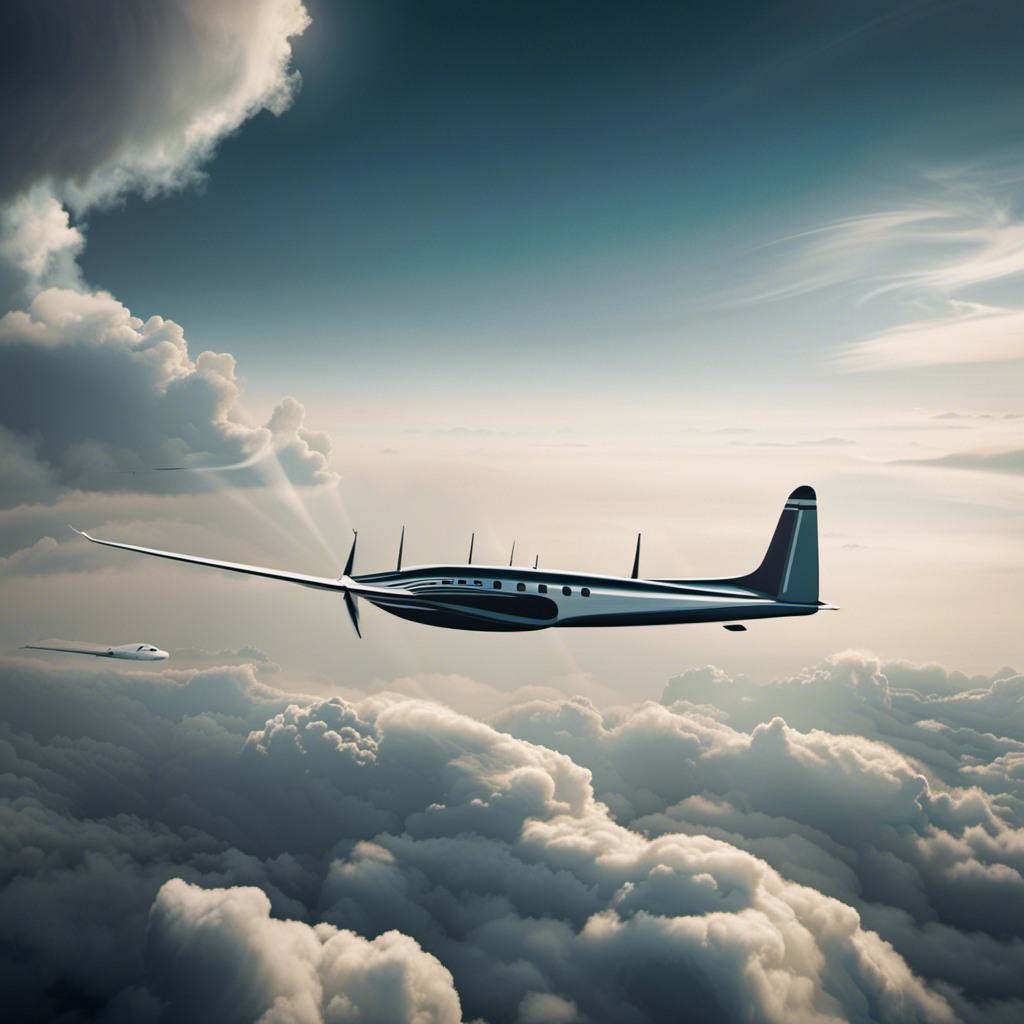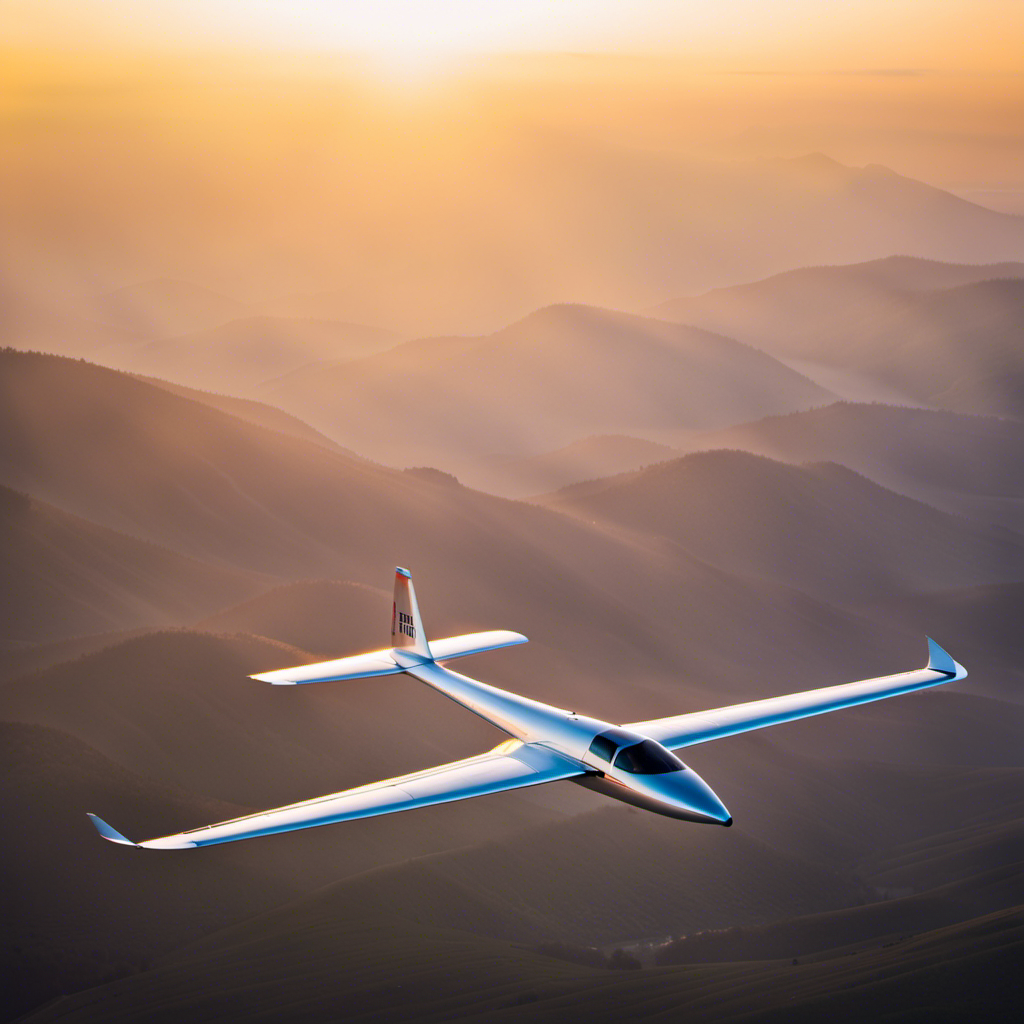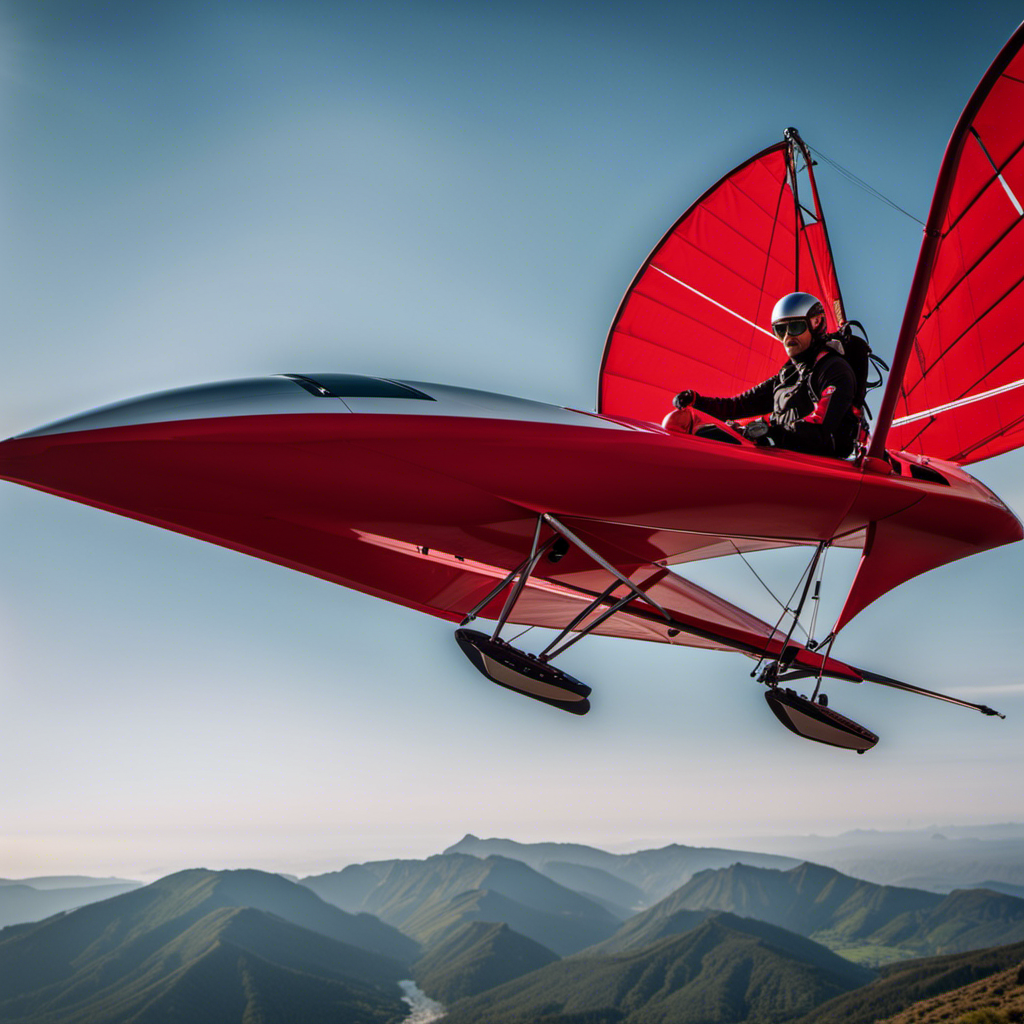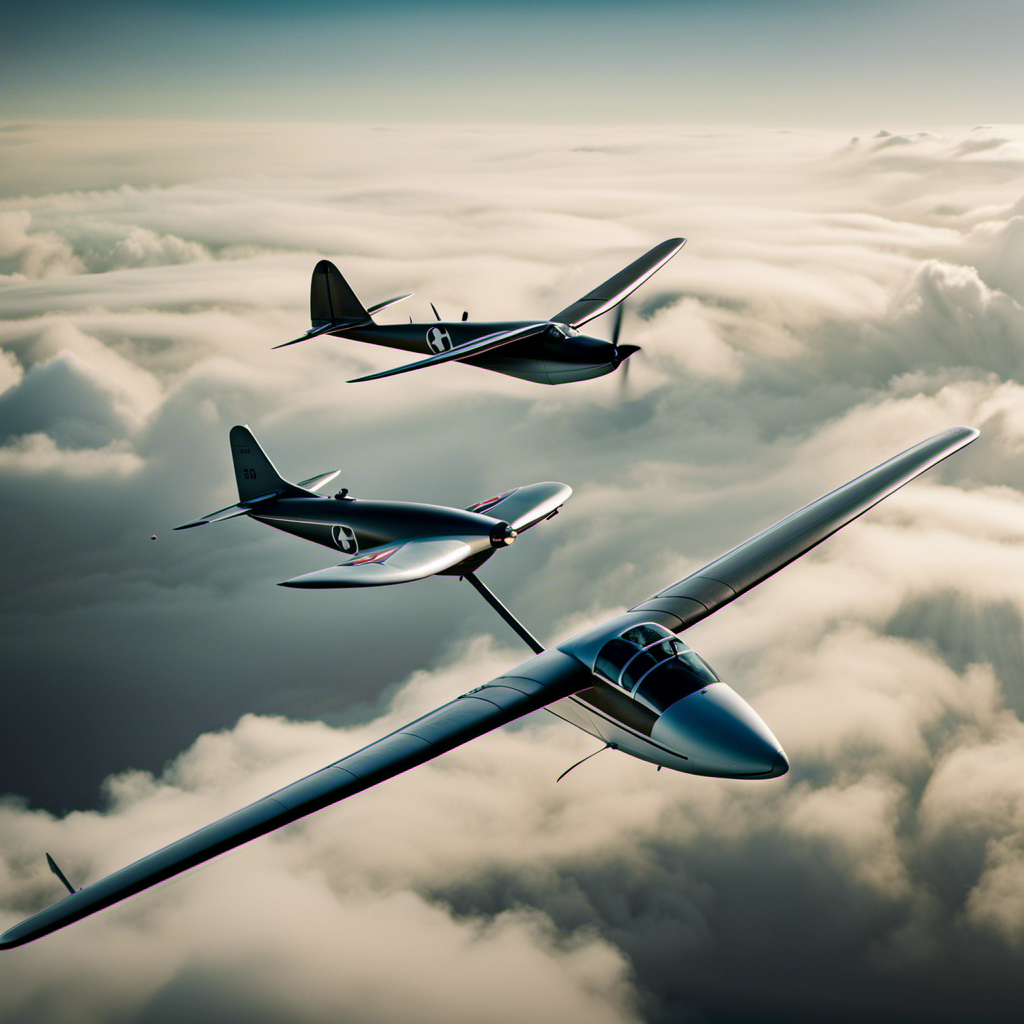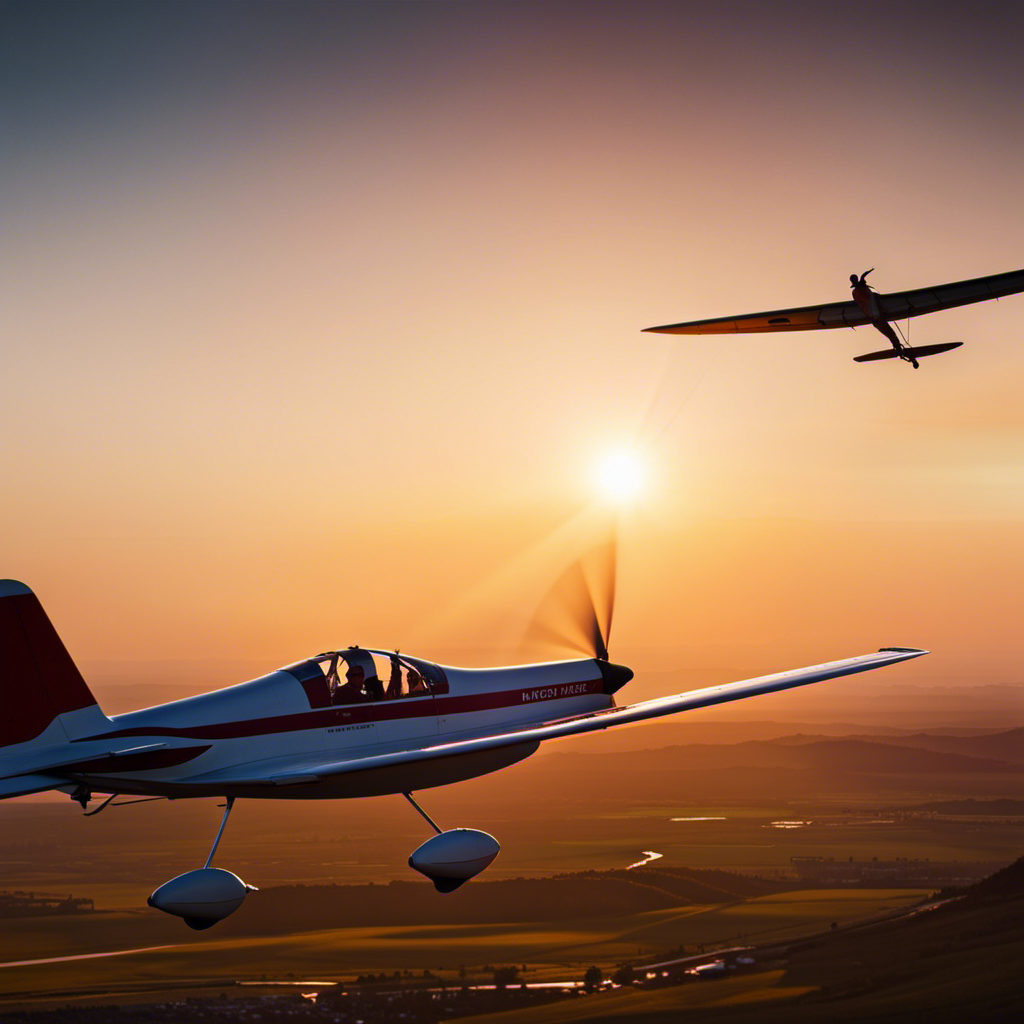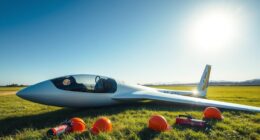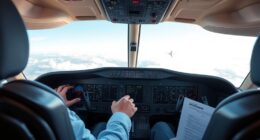As someone who is passionate about aviation, I often find myself pondering the distinctions between gliders and airplanes. What sets apart these two incredible flying machines?
In this article, we’ll embark on a journey to explore the exact disparities between these aerial wonders. From their design and propulsion systems to their flight capabilities and pilot experiences, we’ll delve into every fascinating aspect.
So fasten your seatbelt, or perhaps unbuckle it for a more serene glide, and let’s unravel the captivating differences between air gliders and airplanes.
Key Takeaways
- Airplanes are powered aircraft that use engines for thrust, while air gliders are unpowered aircraft that rely on gravity and air currents to stay aloft.
- Air gliders have a simpler design with fewer moving parts, reducing the risk of mechanical failures and eliminating the risk of fuel-related accidents.
- Gliders have longer wingspans and high aspect ratio wings for increased lift and soaring in thermals, while airplanes have shorter wingspans and lower aspect ratio wings for better maneuverability and higher speeds.
- Airplanes have engines for propulsion, allowing for greater control, maneuverability, speed, and range, while air gliders rely on natural forces and are highly efficient, staying in the air for extended periods by exploiting rising air currents.
Basic Definition of Air Gliders and Airplanes
Air gliders and airplanes may seem similar, but they have distinct differences in their basic definitions.
In transportation, airplanes are powered aircraft that use engines to generate thrust and propel themselves through the air. They rely on the principles of aerodynamics to maintain lift and control their flight.
On the other hand, air gliders are unpowered aircraft that use natural forces like gravity and air currents to stay aloft. They are designed to glide through the air without the need for an engine.
In sports, airplanes are commonly used for activities like skydiving and aerial photography, while air gliders are specifically designed for competitive gliding events.
Now, let’s explore the design and structure differences between these two fascinating flying machines.
Design and Structure Differences
When it comes to the design and structure of airplanes and air gliders, there are several key points to consider.
First, the wingspan and wing shape play a crucial role in determining the performance and stability of the aircraft.
Additionally, the control mechanisms, such as ailerons and elevators, allow for precise maneuverability in the air.
Finally, the fuselage and cockpit design play a vital role in providing a comfortable and safe environment for the pilot.
These factors combine to create a well-designed and efficient aircraft.
Wingspan and Wing Shape
To understand the difference between gliders and airplanes, you’ll notice that the wingspan and wing shape play a crucial role.
Wingspan variations directly affect the aerodynamic efficiency of an aircraft. Gliders typically have longer wingspans compared to airplanes. The longer wingspan allows gliders to generate more lift, enabling them to stay aloft for longer periods without the need for an engine. This increased lift also allows gliders to soar in thermals and take advantage of updrafts.
On the other hand, airplanes often have shorter wingspans, which provide better maneuverability and allow for higher speeds. The wing shape also differs between gliders and airplanes. Gliders typically have high aspect ratio wings, which are long and narrow, providing greater lift-to-drag ratios. In contrast, airplanes often have lower aspect ratio wings, which provide better agility and stability.
Understanding these differences in wingspan and wing shape is essential in comprehending the distinct characteristics of gliders and airplanes.
Moving forward to the discussion on control mechanisms, we delve into how these aircraft are operated and controlled without external power sources.
Control Mechanisms
Moving forward, we’ll explore how gliders and airplanes are controlled and operated without relying on external power sources. The control mechanisms in both gliders and airplanes are crucial for maneuvering and maintaining stability during flight. These mechanisms include the ailerons, elevators, and rudder, which are operated by the pilot through the use of control surfaces. By adjusting the position of these control surfaces, the pilot can influence the aircraft’s movement and attitude.
The principles of aerodynamics play a significant role in the operation of these control mechanisms. The design and positioning of these surfaces are carefully calculated to ensure optimal control and stability.
Now, let’s delve into the next section, where we will discuss the importance of fuselage and cockpit design in gliders and airplanes.
Fuselage and Cockpit Design
The fuselage and cockpit design in both gliders and airplanes play a crucial role in ensuring the safety and comfort of the pilot and passengers.
When it comes to fuselage materials, aircraft manufacturers carefully choose materials that are lightweight yet strong, such as aluminum alloys or composite materials like carbon fiber reinforced polymers. These materials provide the necessary structural integrity while minimizing weight, allowing for better fuel efficiency and performance.
In terms of cockpit ergonomics, engineers consider factors like visibility, accessibility of controls, and the overall comfort of the pilot. Instruments and controls are strategically placed for easy reach and visibility, and seats are designed to provide support and minimize fatigue during long flights.
Now, let’s move on to the next section, where we’ll discuss the propulsion systems used in gliders and airplanes.
Propulsion Systems
You’ll notice that air gliders rely on natural forces for propulsion, while airplanes use engines to generate thrust.
Air gliders, like sailplanes, rely on the forces of gravity, lift, and drag to stay aloft and move through the air. This makes them highly efficient in terms of propulsion, as they do not require the use of fuel or engines.
Airplanes, on the other hand, use engines to generate thrust, which propels them forward through the air. While this allows airplanes to have greater control and maneuverability, it also comes with a higher environmental impact, as the burning of fuel releases greenhouse gases into the atmosphere.
Transitioning into the subsequent section, let’s now explore the flight capabilities and performance of air gliders and airplanes.
Flight Capabilities and Performance
When flying an air glider or an airplane, it’s important to understand the difference in their flight capabilities and performance. Air gliders rely on natural air currents to stay aloft, while airplanes are powered by engines. This fundamental distinction affects their flight performance in several ways.
Airplanes have the advantage of greater speed and range due to their propulsion systems, allowing them to cover long distances efficiently. Additionally, airplanes are more maneuverable, thanks to their powered controls and ability to perform aerobatic maneuvers.
Air gliders, on the other hand, excel in their ability to stay in the air for extended periods, as they can exploit rising air currents to gain altitude and sustain flight. Understanding these differences is crucial for pilots to make informed decisions and operate these aircraft safely.
Now let’s shift our focus to the pilot and passenger experience.
Pilot and Passenger Experience
Pilots and passengers can have a unique and exhilarating experience when flying in different types of aircraft. When it comes to pilot safety, both air gliders and airplanes have their own set of advantages.
Air gliders, for example, have a simpler design with fewer moving parts, which can reduce the risk of mechanical failures. Additionally, the absence of an engine in air gliders means that there is no risk of fuel-related accidents.
On the other hand, airplanes are equipped with advanced safety systems, such as anti-icing technology and redundant control systems, ensuring a safer flight experience.
In terms of passenger comfort, airplanes generally offer more amenities, such as climate control, comfortable seating, and in-flight entertainment. However, air gliders provide a unique sense of freedom and tranquility, allowing passengers to fully immerse themselves in the beauty of flight.
Transitioning into the subsequent section on training and certification requirements, it is crucial for pilots to undergo rigorous training to ensure the safe operation of both air gliders and airplanes.
Training and Certification Requirements
In order to fully understand the differences between air gliders and airplanes, it is important to delve into the training and certification requirements for piloting each aircraft.
As a pilot, I went through extensive training to obtain the necessary skills and knowledge to fly both air gliders and airplanes. The training requirements for air gliders involve learning about aerodynamics, meteorology, navigation, and emergency procedures specific to gliding. Once the training is complete, pilots must pass a certification process that includes written exams, practical flight tests, and a thorough review of their flying skills.
On the other hand, the certification process for airplanes involves additional training in areas such as engine systems, instrument flying, and radio communication. This comprehensive training and certification process ensures that pilots are well-equipped to handle the unique challenges of each aircraft.
Now, let’s move on to explore the cost considerations associated with air gliders and airplanes.
Cost Considerations
The cost of owning either an air glider or an airplane can vary significantly depending on factors such as maintenance, fuel, and insurance. When considering the cost effectiveness of these aircraft, it is important to take into account the maintenance expenses.
Both air gliders and airplanes require regular maintenance to ensure their safe operation. However, the maintenance expenses for an airplane tend to be higher compared to an air glider. Airplanes have complex systems and engines that require more frequent inspections and servicing. Additionally, the cost of airplane parts and labor can be quite high.
On the other hand, air gliders have simpler structures and fewer mechanical components, resulting in lower maintenance costs. This makes air gliders a more cost-effective option for those looking to minimize ongoing expenses.
Transitioning into the subsequent section about different types and variations, it is important to understand the various models and configurations available for both air gliders and airplanes.
Different Types and Variations
When discussing the different types and variations of aircraft, it is important to understand the distinctions between gliders and airplanes.
Gliders, such as sailplanes, hang gliders, and paragliders, rely solely on wind currents for propulsion.
Airplanes, including commercial, private, military, and recreational aircraft, utilize engines for powered flight.
Additionally, there are specialized variations within these categories.
For example, there are amphibious aircraft capable of landing on both land and water.
There are also aerobatic planes designed for acrobatic maneuvers.
And there are experimental aircraft that push the boundaries of aviation technology.
Types of Gliders (Sailplanes, Hang Gliders, Paragliders)
Did you know that sailplanes, hang gliders, and paragliders are the different types of gliders? Gliders are aircraft that are designed to fly without an engine, relying solely on the forces of lift and gravity to stay airborne.
Here are the main differences between sailplanes and paragliders, as well as hang gliders and sailplanes:
-
Sailplanes vs. Paragliders:
- Sailplanes have a fixed wing and are usually made of composite materials, allowing for longer flights and better performance.
- Paragliders have a flexible wing and are made of lightweight fabric, providing a more portable and affordable option for recreational flying.
-
Hang Gliders vs. Sailplanes:
- Hang gliders have a rigid wing and are controlled by shifting body weight, offering a more dynamic and hands-on flying experience.
- Sailplanes have a fixed wing and are controlled through conventional flight controls, offering a more stable and controlled flight experience.
Now that we have explored the different types of gliders, let’s dive into the various types of airplanes, including commercial, private, military, and recreational aircraft.
Types of Airplanes (Commercial, Private, Military, Recreational)
Moving on from discussing the various types of gliders, let’s delve into the different types of airplanes.
As a pilot, it’s essential to understand the distinctions between commercial, private, military, and recreational aircraft.
Commercial airplanes are designed for transporting large numbers of passengers and require highly qualified pilots to operate them.
Private airplanes, on the other hand, are typically owned by individuals and used for personal travel.
Military aircraft are specially built for combat and defense purposes, with stringent pilot qualifications and maintenance requirements.
Finally, recreational airplanes are meant for leisure activities such as aerial sightseeing or sport flying.
Understanding these categories is crucial for pilots, as it determines the specific qualifications and maintenance protocols they must adhere to.
Now, let’s explore the specialized variations of airplanes, including amphibious, aerobatic, and experimental models.
Specialized Variations (Amphibious, Aerobatic, Experimental)
Let’s now explore the various specialized variations of airplanes, such as amphibious, aerobatic, and experimental models.
Amphibious gliders are aircraft that can land and take off on both land and water. They are equipped with retractable landing gear and floats, allowing them to operate in both environments. These gliders are commonly used for search and rescue missions and recreational flying near water bodies.
On the other hand, experimental airplanes are designed for research and development purposes. They often incorporate new technologies, materials, or unconventional designs. Experimental airplanes play a crucial role in advancing aviation by testing new concepts and pushing the boundaries of what is possible.
Understanding the distinctions between these specialized variations of airplanes is essential to comprehend their applications and uses in the aviation industry.
Applications and Uses
You’ll find that air gliders and airplanes have different applications and uses.
Airplanes are designed for various purposes, such as transportation, military operations, and aerial photography. Their ability to carry heavy loads, fly long distances, and reach high speeds makes them ideal for these applications. Moreover, airplanes offer advantages such as versatility, accessibility to different terrains, and the ability to fly in various weather conditions.
On the other hand, air gliders are primarily used for recreational purposes, such as gliding competitions and leisurely flights. Their advantage lies in their ability to stay airborne for extended periods without an engine, relying solely on the natural forces of the atmosphere.
Looking ahead, future developments and innovations in both air gliders and airplanes will continue to enhance their applications and improve their performance, ushering in new opportunities for aviation enthusiasts and professionals alike.
Future Developments and Innovations
When it comes to future developments and innovations, there are exciting possibilities for both air gliders and airplanes. Technological advancements in materials, propulsion systems, and aerodynamics will shape the future of these aircraft.
In the case of air gliders, we can expect to see improvements in efficiency and range through the use of lightweight composite materials and advanced wing designs. Additionally, advancements in energy storage and electric propulsion systems may pave the way for more sustainable and environmentally friendly gliders.
As for airplanes, future developments will likely focus on enhancing speed, fuel efficiency, and safety. This may involve the use of advanced propulsion technologies, such as hybrid or electric engines, as well as the integration of artificial intelligence for improved flight control systems.
Overall, the future of both air gliders and airplanes looks promising, with exciting potential for technological advancements that will revolutionize the way we fly.
Frequently Asked Questions
Are air gliders and airplanes considered to be safer modes of transportation compared to other forms of travel?
Air gliders and airplanes are generally considered safer modes of transportation compared to other forms of travel. They undergo rigorous safety inspections, have trained pilots, and are equipped with advanced technology to ensure passenger safety.
How do air gliders and airplanes differ in terms of their environmental impact and carbon emissions?
In terms of their environmental impact and carbon emissions, air gliders and airplanes differ significantly. Airplanes emit more carbon dioxide due to their reliance on fuel combustion, while air gliders have a lower environmental impact as they rely on wind currents for propulsion.
Can air gliders and airplanes be used for aerial photography and videography purposes?
Air gliders for recreational purposes are suitable for capturing aerial photography and videography due to their ability to soar silently and stay aloft for long periods. However, airplanes offer advantages like stability, versatility, and the ability to carry sophisticated camera equipment.
What are the main factors that contribute to the cost differences between air gliders and airplanes?
Factors such as manufacturing materials, engine type, size, and complexity of systems contribute to the cost differences between air gliders and airplanes. These variances in design and functionality directly impact the production and maintenance expenses.
Are there any new technologies or advancements in the works that could potentially revolutionize the design and performance of air gliders and airplanes in the future?
New technologies and advancements in the works have the potential to revolutionize the design and performance of both air gliders and airplanes. These innovations will enhance their aerodynamics, fuel efficiency, and overall capabilities.
Conclusion
In conclusion, air gliders and airplanes may seem similar at first glance, but their differences are significant.
From their design and structure to their propulsion systems and flight capabilities, each aircraft offers a unique experience for pilots and passengers alike.
While airplanes dominate the skies with their powerful engines and impressive speed, air gliders rely on the art of soaring effortlessly through the air.
As technology continues to advance, we can only anticipate exciting developments and innovations in both types of aircraft, shaping the future of aviation in ways we can only imagine.
Orion, better known as “Jetstream,” is the voice that brings the stories of the skies to life. His fascination with aviation began at a young age, sparked by his father’s tales of flying and adventure. Orion’s journey into the world of gliding was serendipitous, and from the moment he took his first glider flight, he knew he had found his calling.
